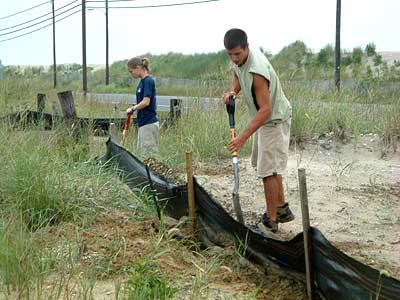Abstracts of Papers
Presented by Wetlands Institute staff at the
Atlantic Estuarine Research Society Spring 2005 Meeting, March 10–12, 2005,
Calvert Marine Museum, Solomons, Maryland
|
Benjamin K. Atkinson
![]()
Terrapin Conservation Project, Wetlands Institute,
1075 Stone Harbor Boulevard, Stone Harbor, NJ 08247, USA
benjaminkatkinson@yahoo.com
Roadkills during the nesting season are a significant source of mortality for female northern diamondback terrapins (Malaclemys terrapin terrapin) along the Atlantic coast of southern New Jersey. In June 2004, researchers from the Wetlands Institute installed a temporary barrier fence along the edge of a six-block section (approximately 0.6 kilometers) of Landis Avenue in Sea Isle City, New Jersey, in an attempt to reduce road mortality of nesting terrapins in an area known to be a major “kill zone.” The site was also selected because it is owned largely by Sea Isle City, and has no buildings except for one condominium. The area is unusual because salt marsh occurs on the fenced side of the road while beach dunes line the other side. Student researchers regularly walked the fence line to maintain its integrity. Signs posted at regular intervals educated the public and provided contact information. The fence, as hoped, reduced the number of roadkills. In 2003 (pre-fence) 19 terrapins were killed at the site. In 2004 only six roadkills were documented. At least four of those six may be attributed to a gap in the middle of the fence necessitated by a dirt road.
|
Scute Anomalies in the Diamondback Terrapin
Ashley Kruegl and Rosalind Herlands
![]()
Terrapin Conservation Project, Wetlands Institute,
1075 Stone Harbor Boulevard, Stone Harbor, NJ 08247, USA
kruegl2@tcnj.edu; research@wetlandsinstitute.org
The northern diamondback terrapin (Malaclemys terrapin terrapin) is a species of turtle that inhabits salt marshes along the mid-Atlantic and southern New England coasts of the United States . Diamondback terrapins have protective shells consisting of bony plates covered, typically, by a set number and arrangement of large scales, or scutes. Some terrapins, however, have anomalies with respect to the number and shape of scutes on their shells. Like most turtles that have been examined, terrapins are characterized by temperature dependent sex determination. Low incubation temperatures produce males while higher temperatures produce females. Research at the Wetlands Institute has shown: (1) anomalies occur in wild terrapin populations; (2) females have a higher percentage of anomalies than males; (3) certain kinds of anomalies occur more frequently than others; and (4) artificial incubation produces a higher percentage of anomalies than is found in hatchlings from natural nests.

